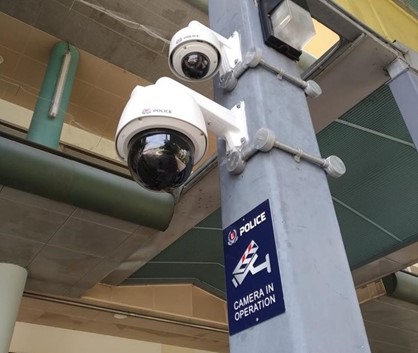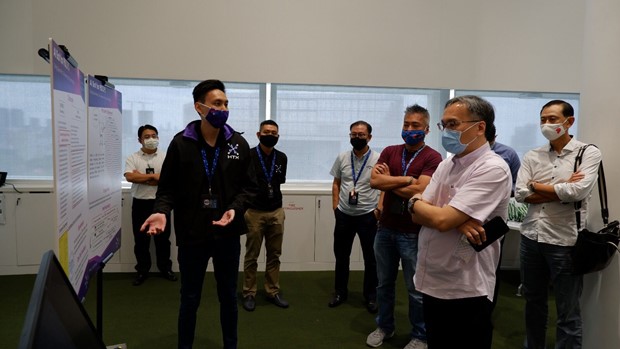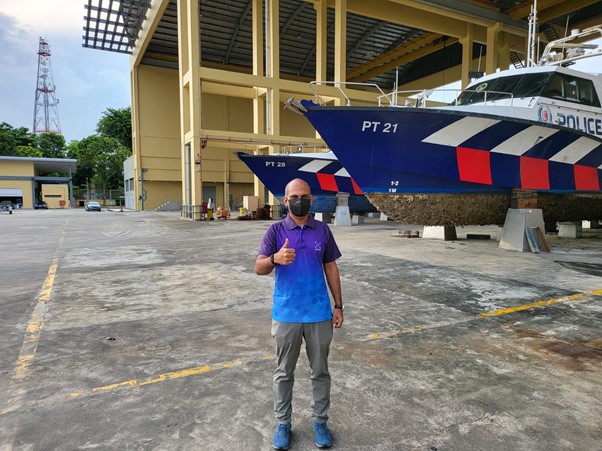Congratulations to all our Minister’s Awards recipients! Every year, four awards are given out at the Minister’s Awards Presentation Ceremony: The Home Team Achievement Award (HTAA), the Operational Excellence (OE) Award, the Star Service Award (SSA), and the HT Innovation Award. These are awarded to teams and individuals for achieving exceptional operational outcomes and performance in major operations, and displaying outstanding service and innovation.
This year, HTX is involved in three multi-agency projects awarded the HTAA. HTX also received 17 OE Awards and four SSA awards! These are the team projects and individuals that won.
Home Team Achievement Award (HTAA)
1. PolCam 2.0
2. Tactical Boat Handling and Firing Simulator
3. Transformation of Police Operations Command Centre
Operational Excellence Award (OE)
1. Agile Procurement Processes to Deliver Urgent and Cost-Effective Outcomes
2. AI Bot for FISOPS
3. MHA Next Generation Transmission Network
4. HTX TechXplore
5. Digitalising Hardcopy Logbook for Boat Operation
6. In-house Performance of Engine Replacements for PT Class Patrol Boats
7. Smart Drone Operator Location Estimation System
8. Ops Albatross
9. Successful operation against group using drone to smuggle drugs between Malaysia and Singapore
10. HTS2 Satellite Centre @ Tanglin Division
11. Digital Change of Address
12. Multi-Agency Study to Reduce Vegetation Fires Along Expressway Road Dividers
13. Arrest of 2 male subjects for Trafficking of Controlled Drugs by flying a drone carrying Controlled Drugs from Johor Bahru, Malaysia into Singapore
14. Operation Fatal Trot
15. Operation Skywalk
16. Case Management System Partner System
17. Operationalisation of a Technologically Advanced Cluster – Selarang Park Complex
Star Service Award (SSA)
1. Tan Heng Chian, Executive, Procurement
2. Edward Heng Aik Hwang, Engineer, Cybersecurity Centre of Expertise
3. Jenny Lim, Procurement Specialist, Procurement
4. Chan Hui Mei (Jo), Senior Forensic Scientist, Forensics Centre of Expertise
In this article, we take a closer look at three award-winning projects – PolCam 2.0, AI Bot for FISOPS, and Digitalising Hardcopy Logbook for Boat Operation – and the people behind them.
PolCam 2.0 – Home Team Achievement Award

PolCams provide real-time camera footage to police officers (Photo: HTX)
On CCTV footage, a man in dark clothes is caught dashing across a deserted street. Vanishing at the edge of the frame, he quickly hurries into a narrow alleyway to make his escape. Just a while prior, he had been responsible for the assault and robbery of a 92-year-old man. With footage capturing his fleeing from the crime scene, he was quickly apprehended – being unable to escape from the long arm of the law.
This scenario is but one example of police cameras contributing to Singapore’s safety and order.
Police cameras – also known as PolCams – have served real and timely needs on the ground, playing an important role in furthering Singapore’s safety and security.
In collaboration with their counterparts from the Singapore Police Force (SPF), this mission has been at the heart of several HTX departments – namely Policing Programme Management Centre (PMC), Joint Capabilities PMC, and Sense-making and Surveillance Centre of Expertise – since the cameras were introduced islandwide in 2012. The cameras have since been upgraded with features such as video analytics capabilities to expedite the search for key relevant footage, and have been successfully implemented across Singapore in our neighbourhoods and public spaces, to keep citizens and streets safe!
With video analytics, footage and images caught on camera are now sharper. This allows officers to comb through footage more quickly and accurately for investigative leads, enhancing the Police Operations Command Centre’s sense-making capabilities. Reflecting on the utility of the upgraded system, Mr Thomas Chee, project manager from Joint Capabilities PMC overseeing the deployment of the sensors, said, “This technology helps the man on the ground. With these cameras, case leads can surface more quickly. Video analytics also help to expedite the search for relevant footage and playback of recorded footage. Otherwise, they need to go through countless footage reels.”
While the PolCam 2.0 project team is thankful that their commitment to enhancing camera intelligence and customising it to meet the Home Team’s specifications and operational outcomes has been recognised by the award, they humbly share that the bigger picture is still to augment SPF and serve the public. In Thomas’s words, “When cameras are able to help SPF in their objective of enhancing public safety and solving crimes, that is when we feel most satisfied. Ultimately, it boils back down to a tangible benefit for the public.”

Project team behind PolCam 2.0; Thomas Chee pictured in the first row, second from left (Photo: HTX)
AI Bot for FISOPS – Operational Excellence Award

Mr Lim Ming En, Q-Team engineer, explaining the process behind the AI bot for FISOPS to Permanent Secretary Pang Kin Keong, at HTX’s inaugural TechXplore (Photo: HTX)
Step 1: Receive file. Download for review.
Step 2: Open file. Check all sections are completed, including a professional engineer’s stamp and receipt.
Step 3: Extract the document title and rename the file as the title.
Sounds laborious? This is the process that SCDF’s Approving Officer (AO) for the Fire and Safety Online Processing System (FISOPS) – SCDF’s system for the processing of all fire and safety related licenses and permits – has to go through for a single application. Often, the required stamp and receipt are missing, and the file is named incorrectly. Multiply this process by the approximately 100 PDF files that come trickling in each day, and this task becomes even more time-consuming.
This problem was first identified by HTX’s Protective Security and Safety Centre of Expertise (PSS CoE) when they conducted a study of how to improve the overall FISOPS process. HTX’s Q-Team CoE then sprang into action to solve this issue, with their development of an Artificial Intelligence (AI) bot. The AI bot combines the power of text and image analytics to automate the process of screening attachments for each fire and safety storage application. It renames the document to change the title and indicates if a stamp is present. The bot will also inform the AO if any document is missing from the application. This technology significantly speeds up the time taken for document screening and reduces the workload of the officer.
Mr Lim Ming En, engineer from Q-Team CoE recounted, “For this project, we really had to work closely with SCDF approval officers to identify their needs and tailor the bot accordingly. Originally, the problem statement – how to make the FISOPS
process faster – was quite broad. It was up to us to figure out what exactly were the pain points that approval officers faced, through constant back-and-forth communication, and come up with a solution that tackled them effectively.”
Achieving the OE award for the FISOPS bot was especially impressive considering this was the first project Ming En worked on in HTX, after he joined as part of the Associate Programme, fresh from graduation. But when asked how he felt about receiving this award, Ming En modestly replied, “Honestly, it was a nice bonus, but I wasn’t expecting this award at all. My motivation was not the award, but to work on technology that could solve problems and help fellow Home Team officers in their work.”
Creating a bot that automates the FISOPS process may not seem like the most glamorous work. However, it is essential in force multiplying the capabilities of Home Team officers, especially with the advent of automation in daily life. In Ming En’s words, “To others, this project may not seem that flashy, but it’s these little things that help hold the whole Home Team system together. To me, knowing that what I do can make the life of another Home Team officer much easier and help him carry out his duties more effectively, gives me a sense of purpose.”
Digitalising Hardcopy Logbook for Boat Operation – Operational Excellence Award

Mr Steven Nathan, Head of Marine Systems and Project Lead of the Digital Logbook Project, pictured with PCG boats (Photo: Steven Nathan)
More than 500 boat operators from six squadrons, each with unique deployment.
Over 100 Police Coast Guard (PCG) boats, with their performance and maintenance programme monitored using metrics ranging from fuel efficiency to defect history.
And now imagine that amount of data squeezed into 300 hardcopy logbooks, filled with dense handwritten information. Add in the fact that each logbook needs to be replaced every two years because of the physical space needed to archive the records…and it becomes even more difficult to keep track of all that data. Moreover, to retrieve information from the logbooks for data analysis and defect investigation, one must flip through numerous pages, which can take days.
These were the problems that HTX’s Marine Systems team (under Platform Systems, Capability Sustainment Centre) set out to solve, by developing digital Electronic Marine Craft Logbooks (EMCLBs) to replace the hardcopy logbooks. With the EMCLBs, there is no longer a need to purchase and store the hardcopy logbooks, thus reducing costs. Instead of handwriting data, PCG operators now select pre-set options in entry fields, saving time and ensuring consistency and quality of data inputted. All the boats’ operational, utilisation and defect information can also be easily retrieved for data analysis and defect investigation at any time, within minutes. Access to such data allows operators to plan ahead for operations. Boats can also be scheduled for deployment via the EMCLBs, something not previously achievable with hardcopy logbooks.
However, it was initially not easy convincing operators the merits of moving to an electronic model. “Understandably, some boat operators were hesitant about switching over to digital logbooks, given that they had been using the hardcopy logbooks for more than 30 years,” said Mr Steven Nathan, Head of the Marine Systems team. “So to overcome this challenge, we spent a lot of effort engaging PCG users. We met up with operators from all six squadrons and talked them through the advantages of the new digital system. We listened attentively to their comments, and applied their feedback to make the digital logbook as user-friendly as possible. User Acceptance Tests were also conducted to ensure the EMCLB design, workflow and interface were acceptable for PCG operators and workshop personnel.” Steven and his teammate, Mr Dinesh Thangavelu, even created WhatsApp groups for each squadron, so that they could address any concerns raised immediately.
Training all operators and attending to all their queries may not have been entirely smooth sailing, but for Steven, it was worth it. Having been in this line of work for more than 25 years, he knew just how tedious retrieving data from hardcopy documents was. “I saw how useful digitalisation could be, and I really wanted to apply that to our work. With the EMCLBs, a lot of critical boat operating information can be collected and stored, enabling better analytics and allowing for more efficient planning.” Such an attitude is in line with Steven’s broader mindset, that new technologies should be embraced, not feared. “We’re in a different era now, and if there is new software that can improve the way we work, then we should adopt them. And as for being able to contribute to this constant evolving of the Home Team - in my own way? I find that very fulfilling.”

